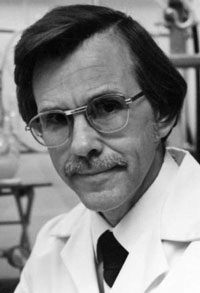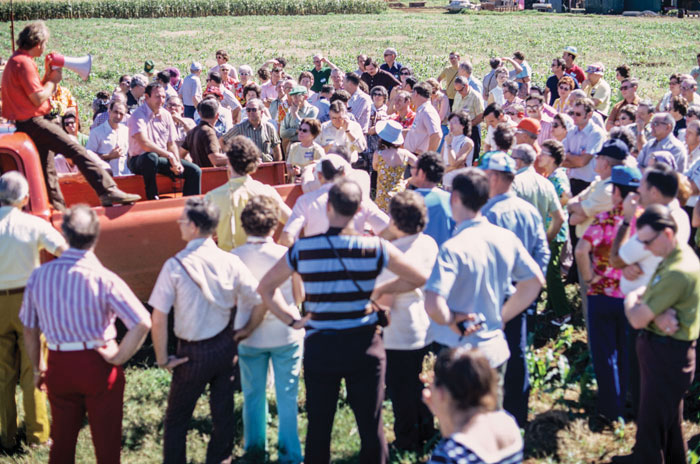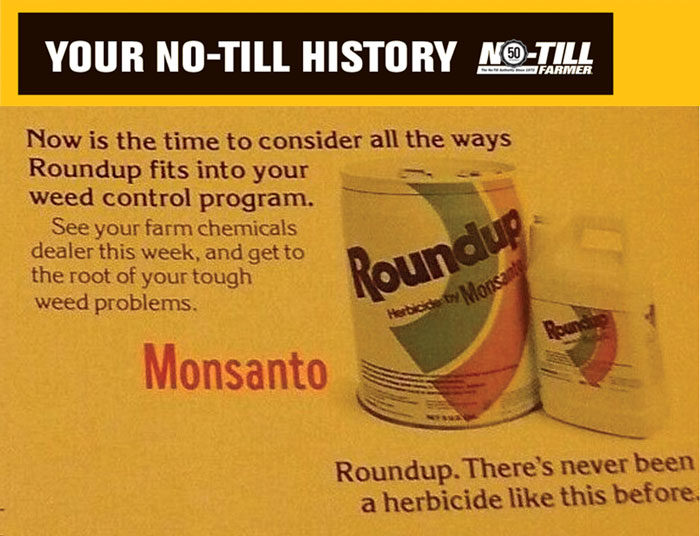Editor’s Note: This installment of “Your No-Till History” expands upon a 1-page article that appeared in June 2022.
Glyphosate (or Roundup), brought to market by Monsanto in the mid 1970s, is a virtually ideal herbicide, says international weed authority Dr. Stephen Powles, and a “once-in-100-years breakthrough” that was “as important for reliable global food production as penicillin is for battling disease.”
Farmers on the 1974 and 1975 Hawaii trips run by No-Till Farmer saw the new herbicide in research plots. Approved to much anticipation in 1976, farmers suddenly had access to a product that promised to eradicate troublesome weeds —without the plow.
It’s no coincidence that U.S. no-till acres grew 2.5 times in Roundup’s first 10 years and 7-fold by the time the exclusive patent expired in 2000. Its enormous impact on no-till — on yields, income and ability to farm more acres with less fuel, machinery and labor — is difficult to quantify, as is the value of keeping soil in its place and avoiding the runoff of sediment and fertilizer.
Indiana no-tiller and conservationist Ray McCormick continues to staunchly defend glyphosate.
“It’s going to save the planet because no-till, cover crops and soil health help sequester the carbon, and Roundup made that possible. Roundup and Monsanto have been heroes.”
To tell the history of glyphosate, we turn to a discovery of our own. We located a 59-page transcript from an oral history project sponsored by the Society of Chemical Industry of Wilkes University Chemistry Professor Dr. James J. Bohning’s 1994 interview with glyphosate herbicide patentee John E. Franz of Monsanto. Franz is now 93.
John E. Franz was the second youngest of six children in his family, raised in Springfield, Ill. His father was manager of a dairy, Sangamon Dairy Products Co., and had only a grade-school education before entering the workforce. His mother was a homemaker, and John would be the only one of the children to pursue a career in science.
Franz attended Springfield Junior College for a year before enrolling at the University of Illinois and then attended the University of Minnesota for his Ph.D. in organic chemistry.
An Impressive Bio
Numerous Monsanto and Bayer (which now owns Monsanto) news releases, coupled with the interview transcript, provide an overview of Franz’ career.
After completing his doctorate in 1955, Franz accepted a job with Monsanto’s Organic Division (Monsanto didn’t have an Agricultural Division until 1960). There he worked on a variety of projects that included polymer flame-retardants.
In 1967, Franz jumped at a chance to transfer to the new Ag Division because he liked its emphasis on publishing, academic contacts and the freedom to pursue ideas.
“For a year, I studied plant physiology and did basic plant growth studies; no chemistry,” Franz says. “During the year I spent with the biologists and plant physiologists I became convinced that the biorational approach was the direction to move in.”

“He tried to get chemists interested in the project, and everybody rejected it. They thought, ‘Dead area! Don’t bother me with this…” – John E. Franz
For discovering glyphosate (Roundup) as a herbicide in 1970, Franz has been recognized with numerous awards — far outstripping the $5 he got from Monsanto for the first glyphosate patent. Some of the most notable honors include becoming the first recipient of the Queeny Award in 1983, Monsanto’s highest technical award to recognize an invention of commercial success. In 1987, Pres. Ronald Reagan presented Franz with the National Medal of Technology, recognizing Roundup’s impact “upon the production of agricultural food and fiber as well as agricultural practices throughout the world.” He also received the Perkin Medal in 1990 in recognition of his contributions to research and development of applied chemistry.
Farm Chemicals magazine, in its September 1994 100th anniversary edition, named the original Roundup herbicide one of the “Top 10 Products That Changed the Face of Agriculture,” in large measure for enabling and encouraging conservation tillage. Two years later, Monsanto received the Presidential Award for Sustainable Development for “pioneering sustainable technologies.”
Franz retired from Monsanto in 1991 with his name attached to more than 840 U.S. and foreign patents. In 2007, he was inducted into the U.S. Inventor’s Hall of Fame.
Start of Roundup’s Discovery
Franz says the “glyphosate as a herbicide” story began in 1960, 10 years before glyphosate was discovered. “The thing that started all this off was a couple of chemists in the Inorganic Division of Monsanto had developed a new process for making a class of compounds called tertiary aminomethylphosphonic acids. This class of compounds were of interest as sequestering agents, detergents and complexing agents.”
When the chemists found a simple process of making the compounds, the inorganic division cranked them out for testing.
“A Fellow who ran the plant physiology section of Ag by the name Dr. Philip Hamm was interested in getting these compounds tested for herbicide and plant growth regulating properties. Apparently, at that time, they weren’t being submitted into a general screen, so he collected them and brought them over to Ag and started screening them because he was head of the screening section.”
Roundup Was Totally Different...
In 1970, most farmers believed they had no choice but to use herbicides and tilling to control weeds. At the time, most herbicides were pre-emergent, meaning they created a chemical barrier on the surface of a field and killed weeds when they sprouted through this barrier and came into contact with the herbicide. To be effective, pre-emergent herbicides had to spread when they were applied to fields, ensuring a consistent, even barrier against sprouting weeds. They also needed to stay active for a long time so they could continue to be effective after the spring rainy season.
These two traits were environmentally problematic because pre-emergent herbicides could wash into streams and ground water, potentially affecting wildlife and fish.
The original Roundup herbicide was different. It was found to decompose into natural products — carbon dioxide, phosphoric acid and ammonia — and to be safe for humans and wildlife. Environmentally speaking, the original herbicide proved to be one of the safest herbicides in the history of agriculture.
Source: Bayer (which acquired Monsanto in 2018) materials on Roundup’s History
Franz noted that the inorganic chemists who originally made these compounds were making them as complexing agents.
“The fact that Hamm had to procure the compounds for ag screening indicated that the inorganic chemists weren’t interested in them as herbicides, and they weren’t even thinking of them in those terms.”
In the screening process, Hamm found two compounds that had interesting perennial herbicidal properties. They were interesting, but weak and not commercial-type products. “Hamm was pretty enthused about it, though, because there weren’t too many compounds that were useful or actually sold for perennial herbicide activity in the early 1960s.”
Glyphosate’s First Field Test
In their 1994 interview, Dr. James J. Bohning asked glyphosate’s discoverer, John Franz, how long it took after the synthesis of his discovery for a field test to show that its promise.
“About 3 months,” Franz says with a laugh. “As a matter of fact, when Dr. Phil Hamm, the head of Monsanto’s herbicide screening program, saw it in the greenhouse for the first time, he said, ‘It’s commercial.’ Just like that.
“Everybody else said, ‘Oh, come on; you can’t know that.’ He knew it. Of course, he had a lot of experience, and he predicted it right off the bat. Well, they really couldn’t tell that from the greenhouse experiments. They did a lot in the greenhouse, what were called primary screening experiments. They also had a whole set of what they called secondary screens, and they skipped those.
“They just took it out in the field because it was getting late in the season. If they wanted to get field studies done, they had to get them out fast before winter set in. So they went right out in the field, and it was very successful. So they knew by the end of the year that it was likely to be commercial, that fast. Yes, it was amazing,
“The plant physiologist who took it out in the field was actually on a plane coming to the test site when he saw the results on the ground. He wrote a big ‘Eureka!’ over the top of the report. This was exciting because it was a major objective in ag to discover a potent new perennial herbicide; it was one of the major projects that they had wanted to do by whatever means.”
No Researchers Wanted the Job
“Hamm was always hoping to be able to get a compound of at least 10-fold higher activity. For the next 9 years, from 1960 to 1969, chemists kept cranking out these compounds and having them tested, but they never could find anything better.
“Hamm kept testing the two compounds that were considered leads in the field, trying to reformulate them and do other things that would improve their activity, but he couldn’t get them up to the point where they could be commercially interesting.”
How it Works
Franz admitted that what made glyphosate’s herbicidal powers active as a herbicide was not well understood initially. Many years later, German professor Dr. Nick Amrhein “found that glyphosate inhibits a specific enzyme in plants that isn’t present in other living organisms, with the exception of some fungi and bacteria. Glyphosate is the only commercial herbicide known to inhibit the enzyme called EPSP synthase (present in most plants). It’s very specific, and no one really, today, still knows why,” he says.
“With most herbicide classes that we have today, you can make hundreds of analogs with similar activity … but not glyphosate. Unbelievable.”
The other researchers all had their own projects going, and here’s Hamm “coming around trying to beat them over the head and put another thing on their agenda,” Franz says. “It turns out, Phil was the type of guy who had hundreds of ideas, most of them bad, but some of them darn good. He just spewed out these ideas, which is good because he wasn’t biased by anything. But he couldn’t convince any of the ag chemists to get interested in the phosphonic acid area of chemistry.
“By 1969, they just about given up hope — at least, all the other people had. Hamm always felt that in the phosphonic acid chemistry area, there was something that was going to be commercial. He didn’t know what, but somebody should keep working in that area, he thought. He went around to various chemists and tried to get them interested in this, and everybody rejected it. They thought, ‘Dead area! Don’t bother me with this.’”
Franz joined the Ag Division in 1967, about the time the program was dying out. “The first thing he did was nab me. I’d had all these other projects going, but he did get me interested — maybe because I didn’t have the biases that the other people had.” The newcomer agreed to take a look and see if he could come up with any ideas.
Franz’ ideas involved other compounds that hadn’t been made and he started some synthesis that was a “total failure.” Proceeding along the same lines, he says, none of these other compounds was any more active than the original ones.

The No-Till Farmer meetings in Hawaii not only introduced farmers to the new no-till concept, but it also gave them a look at glyphosate in 1974, 2 years before it would be approved for use. Image From Maverick to Mainstream: A History of No-Till Farming
“By early 1970, I was about ready to terminate that project, too, but something told me I ought to at least try it from a different perspective. You know, try to think of some way to approach the problem on a totally different basis than just a chemistry synthesis viewpoint, which is the way chemists usually operate.
“I started thinking in biological terms, instead of synthesis, and I came up with this hypothesis: maybe the lead compounds were metabolized by the plants to produce something common that was more active.”
Franz wrote a hypothetical scheme, which he admitted didn’t look promising, but he started making the metabolites, first with the tertiary aminomethylphosphonic acids and then the secondary ones, which no one at Monsanto had done before.
An Amazing 3-Peated Discovery
According to Roundup history by Bayer, Dr. Phil Hamm was the head of Monsanto’s herbicide screening program and was excited about two compounds that were submitted from chemists in another Monsanto division that were studied as water softeners. He asked the newly transfered Franz to study them for herbicidal use.
Franz theorized that a beneficial compound might be produced during the plant’s metabolic process, and if he was lucky, he might be able to synthesize one of these compounds. In 1970, the third compound he synthesized (glyphosate) would become the active ingredient in the original Roundup formulation that would change the face of farming.
Franz recalled how he thought he’d made a new compound. “Monsanto’s legal team did a more thorough search and found a patent issued to Stauffer in 1961 for glyphosate relative to phosphonic acids. Stauffer only saw its prospects as a descaling and metal chelating agent.
“Even though Stauffer was an agriculture company, they didn’t realize that it had any herbicidal properties,” he says. “They never tested it.”
So Stauffer (1960) had glyphosate 10 years before Franz and Monsanto (1970), yet Franz also pointed to a third player who failed to understand glyphosate’s capabilities. In 1950, glyphosate “was made at an obscure pharmaceutical company called Cilag in Switzerland,” he says. “Chemist Dr. Henri Martin made it as a possible antibiotic. When they tested it and it didn’t work, they just put it in their chemical storeroom.” Martin’s work was never published.
When Cilag went out of business, Franz says Alfred Bader of Sigma-Aldrich purchased its research samples, including glyphosate, and offered them for sale in the firm’s catalog of rare chemicals. “Anybody could have bought this compound before I even made it.” Had any samples been screened for herbicidal use, no-till could have seen a better start than its plodding pace of just 3.3 million acres in its first 10 years of commercial use.
After a series of great years to start the 1970s, Stauffer fell on hard times and was sold to ICI in 1987. Meanwhile, by the late 1980s, Monsanto was earning roughly $1 billion per year from Roundup alone, Franz says.
He had 3-4 secondary acids in his scheme. The first one he made was “deader than a door nail” and showed no activity whatsoever.
Luckily for agriculture, Franz figured that was “par for the course” and kept at it. “I was convinced I was going to complete the synthesis of all the compounds that I had postulated from my hypothesis, so I went on and made the next one.
“The second one was glyphosate, and yes, I was as surprised as everybody else that it was really quite active. It was at least 10 times more active than the lead compounds, so that’s what started the glyphosate program.
“The funny thing is, of all the analogs of glyphosate we’ve made since then — every reasonable one we could think of — none of them are active.”
QUOTABLES: Favorite Franz Phrases
Dr. James J. Bohning’s 1994 interview with glyphosate herbicide patentee John E. Franz of Monsanto was part of an oral history project sponsored by the Society of Chemical Industry.
Here are 3 additional of the highlights from that interview:
3 Phases of Discovery. “It has been said that the reception of an original contribution to knowledge may be divided into three phases. First, it’s ridiculed as not true. Second, people say there may be something to it, but it will never be of any practical use. Third, when the discovery has received general recognition, there are people who say that it is not original and has been anticipated by others, or is obvious.”
Franz was talking about glyphosate, but the first two phases could have applied to the no-till practice as well.
Joining the Ag Division. “I was given a project to work on plant growth regulators, but I was just told to do whatever I’d come up with. They didn’t assign me to anything specific. They said, ‘Work on plant regulators, and let’s see what you can do.’ Of course, the first thing I had to do was learn about plant growth regulation, which I didn’t know anything about. I had to read some plant physiology and biology books, study plants in the greenhouse, that sort of thing. Then I started some programs on trying to make various analogs of plant growth hormones and got involved in that research.”
Tackling the Task. “You know, when somebody discovers something like glyphosate, in the beginning, they say, ‘What are you working on that for? That’s already been worked on 9 years; you’re wasting your time.’ As matter of fact, when I went in to talk to my research manager ... his response was, ‘Well, you’re a Fellow, you can do it, but you’re just wasting your time. If you want to do it, it’s all right with me, but it’s looking down a dead horse’s mouth. I can tell you; it’s just going to be a waste of time.’”
Hypothesizing & Thinking Differently. “Why not make some secondary products and see what they do?” That idea evolved out of the hypothesis that metabolism might produce secondary amines. I don’t know if I would have done it otherwise or not without the hypothesis. But most things you do that are different are the result of hypotheses that you have. Most of them are wrong, but that doesn’t matter; if it instigates new experiments, that’s really the value of hypotheses.”
The 2024 No-Till History Series is supported by Calmer Corn Heads. For more historical content, including video and multimedia, visit No-TillFarmer.com/HistorySeries.








Post a comment
Report Abusive Comment